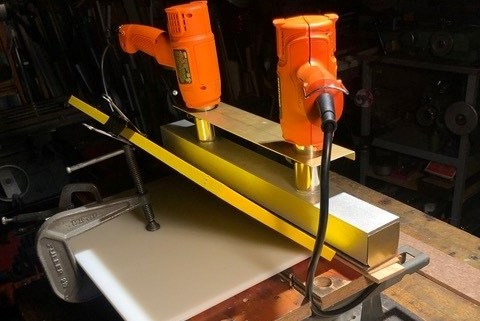Patent-pending welder rapidly melts thermoplastics
The FlatJet Welder, designed for thermoplastic components of all sizes, blasts a thin, directed jet of uniform, high-temperature air/gas for a fast, full-surface melt.

Shown here is the FlatJet Welder with two hot air guns (1,100ºF; 600ºC) set up for long, narrow, right-angle butt welding. A weld gap is exposed by tilting the yellow plate along a face-edge of the horizontal white plate. After a full-length sheet jet melts them in the gap, the yellow plate is vertically raised and forced down. Photo Credit: Winston MacKelvie
The FlatJet Welder is a patent-pending design that provides rapid surface melt to thermoplastic components, enabling quick, complete welds. Currently this is said to be a limitation to the use of thermoplastic materials, whose optimized mechanical properties but low surface energy precludes adhesive bonding. Current welding is also often limited to small areas and is a slow process.
The FlatJet Welder blasts thin, directed jets of uniform, high-temperature air/gas at tape-contact or into gaps between components of any size, rapidly liquefying the entire surface in seconds. Multiple welders may be placed around the gap to supply an unlimited and consistent heat supply.
FlatJet is available for sale and/or a joint venture. For more details and samples, contact its inventor, Winston MacKelvie, by email (winstonworks@me.com) or by phone (P: 450-243-6850, C:450-330-4293).
Related Content
-
The AAMMC Tech Hub: Ramping U.S. production of large thermoplastic composite aerostructures
CW talks with Syensqo, Spirit AeroSystems and other consortia members about current funding, specification of the next world’s largest press, organizational structure and projects to support U.S. companies in the race to deliver >40,000 sustainable and efficient aircraft over the next 20 years.
-
Plant tour: Daher Shap’in TechCenter and composites production plant, Saint-Aignan-de-Grandlieu, France
Co-located R&D and production advance OOA thermosets, thermoplastics, welding, recycling and digital technologies for faster processing and certification of lighter, more sustainable composites.
-
The potential for thermoplastic composite nacelles
Collins Aerospace draws on global team, decades of experience to demonstrate large, curved AFP and welded structures for the next generation of aircraft.



